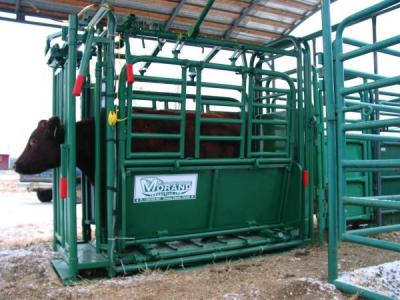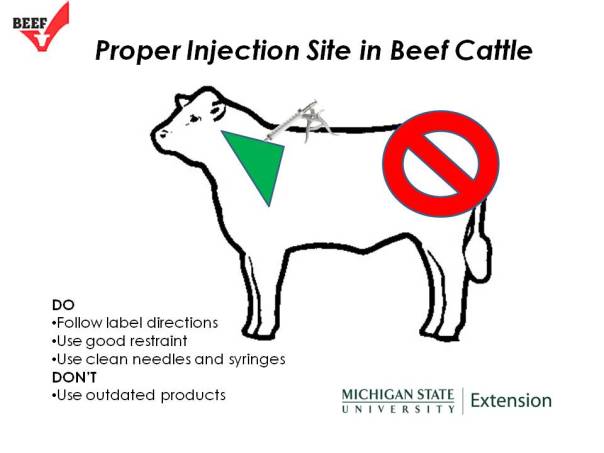Blog Archives
What I know about “pumping antibiotics into your future steak or hamburger”
“104.7!”

image courtesy of http://www.agandfoodlaw.com
“Bio 11!”
Someone moves to fill the syringe with 50 mL’s of dark, syrupy liquid and attaches a 3/4″ needle. Five small injection sites later, a steer leaves the chute with a clang.
*(normal temp is 101.5, so 104.7 as referenced above is considered very sick)
Every day, I inject numbers of sick, fevered* cattle with antibiotics. Cattle that will soon be entering the supermarket as your favorite burger or steak or brisket. By now, every American is well versed in the dangers of overusing antibiotics both in animals and people. Giving your toddler antibiotics for every round of sniffles will make a medicine-resistant germs that will infect your loved one later, and leave them prone to more allergies. Antibiotic residues entering your body through food has been linked to having the same effect (although these studies are still largely inconclusive).
So let’s consider this: Are we creating super bugs that can run rampant through our population, making us miserable and sending medical experts reeling for new drugs to stop the ever-stronger pathogens??
First, we need to understand that there are very similar principles involved with human and animal antibiotic use. Just because we’ve learned antibiotics are NOT the answer to everything, especially viruses which can’t be cured with them anyway, doesn’t mean there is not a place for them. There are times when antibiotics are incredibly useful. Ever had strep throat? Antibiotics are a life-saver! Without taking antibiotics, strep throat poses the risk of becoming bad enough to hospitalize you for kidney damage or heart valve inflammation. Before antibiotics, people died from simple sickness. The same is true in cattle. It is not the answer for everything, but it can ultimately prevent a death by treating an illness before it overtakes the animal’s body or spreads to the entire herd to create an epidemic. And a dose of antibiotics can save significant levels of animal suffering, which I think most human beings would agree is our invaluable responsibility for the animals in our care.
Second, not only do veterinarians monitor the use of antibiotics in food animals, but the FDA is incredibly involved. They do continuous studies to ensure that there are no residual drugs, hormones, or pesticides of any kind entering your body through a steak, hamburger (or veggie!). They work directly with the drug companies to test the meat treated with antibiotics. Over the years, injections have been moved onto the neck (instead of the rear) to help both with bruising the animal and the damage to the meat. These FDA restrictions have also lead to withdrawl times, which are well-known and strictly enforced by every working member on the feedyard. A withdrawl time is set by the FDA and printed on the drug label for easy access. Many steps are taken to ensure no antibiotics are in the cows system at all by the time they are slaughtered:

Cattle are restrained in a chute for cattle/person safety, cattle comfort, and injection accuracy. Photo courtesy of http://www.morandindustries.com
- Animals are only injected in the neck instead of the rear of the animal. This means that in fact, the more popular cuts of beef (round, steaks, etc) are not ever directly injected with antibiotics. Antibiotics are also injected subcutaneously, or just under the skin, instead of directly into the muscles that you eat.
- Several injection sites are used in order to prevent a high concentration of antibiotics in one region. If the medication is not properly spread out, it can sort of ball up under the skin and does not circulate properly (therefore not being as effective in treating the sickness)
- The withdrawal time (in the case of Bio, ~30 days), means that any animal given Bio absolutely under NO circumstances can leave the yard for that time period, until it is positively known that the animal does not have any trace of antibiotic travelling through their bodies.
- Every animal that is run through the hospital receives a hospital tag. This tag is individual to this animal, and is also entered into a computer database.
- Any animal that receives an antibiotic gets a notch cut out of the ear tag in a specific area to signify which drug has been given, so you can look at the animal and see that they have been treated during their stay on the feedlot
- The computer system tracks the date and dosage of every trip through the chute, whether or not it gets antibiotics
- If an animal has received 3 doses of antibiotics and comes back sick again, it is deemed “Chronic” and will be put down if it becomes too ill/fails to recover. Even feedlots recognize that there is a point to which antibiotics are not doing their job, and continuously treating an animal not only increases risk of it retaining an illness, but also stresses an animal. Unfortunately, if an animal doesn’t get better after our best efforts, the best option is to put the animal out of his misery and continue to protect the people consuming beef daily.
- When a pen of cattle is shipped (to slaughter), all animals of that pen are checked to be sure they are “clear” –they have met every withdrawl time and therefore are not containing any drug residues.
- Any animal that is not clear must be moved to an entirely different pen prior to the ship to ensure that no one accidentally adds them to the truck.
- As the pen ships, it is entered as such in the computer. The computer also checks again for any “Hot” (not met withdrawal times) animals. If after all the human checks, the computer finds that a hot animal is on the truck, the entire truck must be stopped on the highway and turned back to the feedyard, where every animal is unloaded and reloaded only after they have ensured that hot animals have been moved off the loading area into the designated “hot” pen. It is very rare that it ever gets to this point (it hasn’t happened in my 5 months here, and I have only ever heard of 1 instance…and many employees have been around for 10+ years)

Healthy Cows are Happy Cows! Photo courtesy of http://www.ericcressey.com
